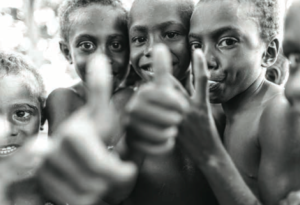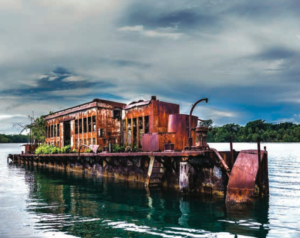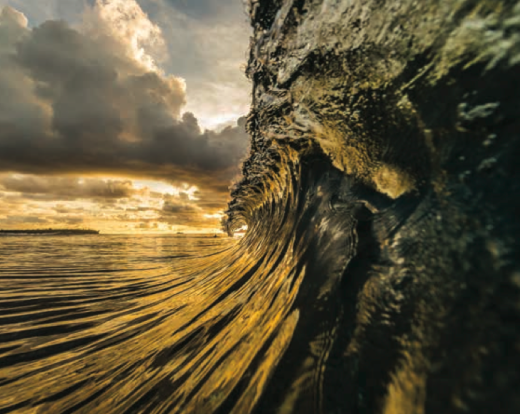Manus Island is be best known for its immigration detention centre, but surfer photographer Joel Coleman reveals the unbridled beauty of the province in which it lies.
There’s an old copy of the Papua New Guinea Lonely Planet guide sitting next to me: outdated, dog-eared and tattered. The opening line of the introduction reads: “PNG is the last frontier for travellers”.
In 1998, I was living on Lord Howe Island, in New South Wales, working as a dive instructor. The captain of the dive boat told me about time he had spent in PNG with the legendary Jean Michel Cousteau (son of Jacques).
The captain spoke of some of the most incredible diving in the world, amazing tropical locations and friendly people. His descriptions of Manus Province sounded like he had found paradise. I promised myself that one day I would get there.
It took 16 years, but it was worth the wait. Surfing is what took me to Manus: no surprise, it takes me pretty much everywhere.
Perspective is defined as: “A particular attitude towards, or way of regarding, something; a point of view.”
Most people’s perspective of Manus Island is what they gather from the media. Very few tourists go there, as very little infrastructure exists to entice them. But surfers have a different perspective on the world. If there is a wave worth surfing, it’s a place worth visiting. From the frozen Arctic waters to the doldrums of the tropics, surfers are out there, looking for waves.

Many who surf want to have a taste of the pioneering days. They want to come around a headland, expecting nothing and finding a new wave; to have it to themselves, to soak it up, to name the break, to own the story.
While most people will tell you that’s what they want to do, they really don’t. It’s kind of like a fantasy that, if lived out, may just cause more problems than it’s worth. And then there are the real explorers, those who will push into a new area, take a punt, go around the next headland just to see what’s there, and if the elements align, they will strike what they are looking for.
The captain and crew of the PNG Explorer are those people.
They have spent years going where other people won’t; running a charter business where others say it is too difficult.
While this is not the first time they have taken the Explorer to Manus, it still has the feel of an exploratory trip.
The swell, winds and tides can throw a lot of curve balls at you, so you never know when a reef may go from lying dormant to rising into a propert, “stand-up-barrel”, kind of wave.
For the first part of this trip, however, we do not get a lot of swell. What we do get is the sheer natural beauty of the islands. It’s easy to forget about the surf when you are floating in gin-clear, 30oC+, water. The islands are so idyllically beautiful and the water so amazingly clear that they redefine my perspective on what a tropical paradise really is.
What we lack in swell during the first half of the trip is more than made up in the second half. I’ll let the photographs do the talking for just how good the surf in PNG can be. Barrels like this really can’t be described in words.

Unless you are completely detached from the news, you will have heard of the asylum-seeker processing centre established on Manus Island that the Australian government.
Before leaving on this trip I mentioned to a few people that I was heading to Manus. I might have even posted something on Facebook or Twitter. Quite quickly, I was hit with several emails from people wanting information on what I was going to do there, questioning whether it was safe and whether I would try to visit the processing centre.
As it turns out, I do end up going to the facility. We anchor for a few nights just off the naval base that has been extended to accommodate the facility, and are invited into the “wet mess” (workers’ bar) for drinks.
I am sure there are journalists and human rights activists who have been doing their utmost to gain access to the facility without success. All we have done is show up with a bunch of surfers, say hello and we are invited in. I am, however, requested not to take any photographs of the facility, so I comply.
What strikes me more than anything is the large amount
of construction work. Talking to some of the people who work there is interesting. The Australians I chat to are not allowed off the base without special permission. They are being paid “danger money” on top of their salaries, and living a life separated from the town of Lorengau, where the facility is located. This may not be the case for everyone who works there, but it was for the people I met.

Given that, earlier in the day, we had absolutely no problems walking through the town, going to the markets and generally hanging out in Lorengau, the danger money received by the workers seems a little over the top. Yet, I am not an expert on such things, merely a photographer that likes to surf.
Essentially the people who I speak to have a narrow perspective on what Manus is really like. They’re shut out from the rest of the islands, the perfect beaches, the crystal-clear water, the surf, the diving and the giggling children of the villages.
I can only hope that there are more people in the world like Captain Andrew Rigby of the Explorer, willing to show how amazing this place really is; people willing to take others there, to let them surf the waves, dive the reefs, get the fine white sand between their toes and the tropical sun on their shoulders, to drink straight from the freshly cut coconuts and dive into the crystal blue water and maybe, just maybe, people’s perspective will start to change.
Don’t limit your perspective, that’s all I’m saying.
Paradise Magazine, May/June 2015

